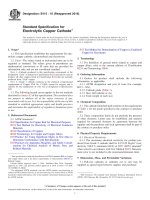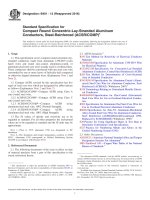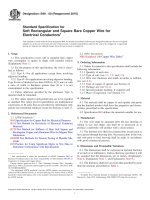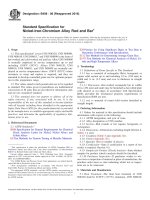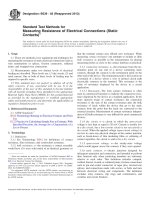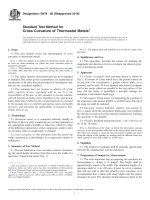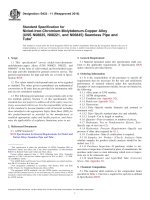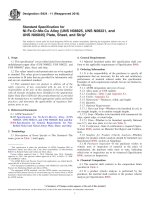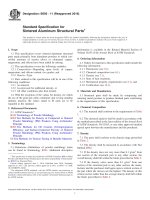Astm b 815 02 (2016)
Bạn đang xem bản rút gọn của tài liệu. Xem và tải ngay bản đầy đủ của tài liệu tại đây (84.61 KB, 3 trang )
Designation: B815 − 02 (Reapproved 2016)
Standard Specification for
Cobalt-Chromium-Nickel-Molybdenum-Tungsten Alloy
(UNS R31233) Rod1
This standard is issued under the fixed designation B815; the number immediately following the designation indicates the year of
original adoption or, in the case of revision, the year of last revision. A number in parentheses indicates the year of last reapproval. A
superscript epsilon (´) indicates an editorial change since the last revision or reapproval.
E8 Test Methods for Tension Testing of Metallic Materials
E29 Practice for Using Significant Digits in Test Data to
Determine Conformance with Specifications
E55 Practice for Sampling Wrought Nonferrous Metals and
Alloys for Determination of Chemical Composition
E1473 Test Methods for Chemical Analysis of Nickel, Cobalt and High-Temperature Alloys
1. Scope
2
1.1 This specification covers cobalt-chromium-nickelmolybdenum-tungsten alloy UNS R31233 in the form of rod
for wear applications and general corrosion service.
1.2 The following products are covered under this specification:
1.2.1 Rods 3⁄16 to 3⁄4 in. (9.76 to 19.05 mm) exclusive in
diameter, hot or cold finished, solution-annealed, and pickled
or mechanically descaled; and
1.2.2 Rods 3⁄4 to 31⁄2 in. (19.05 to 88.9 mm) inclusive in
diameter, hot or cold finished, solution annealed, ground, or
turned.
3. Terminology
3.1 Definitions of Terms Specific to This Standard:
3.1.1 rod, n—product of round solid section furnished in
straight lengths.
4. Ordering Information
1.3 The values stated in inch-pound units are to be regarded
as standard. The values given in parentheses are mathematical
conversions to SI units that are provided for information only
and are not considered standard.
1.4 This standard does not purport to address all of the
safety concerns, if any, associated with its use. It is the
responsibility of the user of this standard to become familiar
with all hazards including those identified in the appropriate
Safety Data Sheet (SDS) for this product/material as provided
by the manufacturer, to establish appropriate safety and health
practices, and determine the applicability of regulatory limitations prior to use.
4.1 It is the responsibility of the purchaser to specify all
requirements that are necessary for material ordered under this
specification. Examples of such requirements include, but are
not limited to, the following:
4.1.1 Alloy.
4.1.2 Dimensions—Nominal diameter and length. The
shortest usable multiple length shall be specified (Table 1).
4.1.3 Certification—State whether certification or a report
of test results is required (Section 15).
4.1.4 Purchaser Inspection—State which tests or inspections are to be witnessed (Section 13).
4.1.5 Samples for Product (Check) Analysis—State whether
samples should be furnished (9.2.2).
2. Referenced Documents
2.1 ASTM Standards:3
B880 Specification for General Requirements for Chemical
Check Analysis Limits for Nickel, Nickel Alloys and
Cobalt Alloys
5. Chemical Composition
5.1 The material shall conform to the chemical composition
requirements prescribed in Table 2.
5.2 If a product (check) analysis is made by the purchaser,
the material shall conform to the requirements specified in
Table 2 subject to the permissible tolerances given in Specification B880.
1
This specification is under the jurisdiction of ASTM Committee B02 on
Nonferrous Metals and Alloys and is the direct responsibility of Subcommittee
B02.07 on Refined Nickel and Cobalt and Their Alloys.
Current edition approved June 1, 2016. Published June 2016. Originally
approved in 1991. Last previous edition approved in 2011 as B815 – 02 (2011).
DOI: 10.1520/B0815-02R16.
2
For ASME Boiler and Pressure Vessel Code applications, see related Specification SB-815 in Section II of that code.
3
For referenced ASTM standards, visit the ASTM website, www.astm.org, or
contact ASTM Customer Service at For Annual Book of ASTM
Standards volume information, refer to the standard’s Document Summary page on
the ASTM website.
6. Mechanical Properties and Other Requirements
6.1 The mechanical properties of the material at room
temperature shall conform to those given in Table 3.
7. Dimensions, Mass, and Permissible Variations
7.1 Diameter—The permissible variations from the specified diameter shall be as prescribed in Table 4.
Copyright © ASTM International, 100 Barr Harbor Drive, PO Box C700, West Conshohocken, PA 19428-2959. United States
1
B815 − 02 (2016)
TABLE 1 Permissible Variations in Length of Rods
Random mill lengths
Multiple lengths
Nominal lengths
Cut lengths
7.6 Weight—For the purposes of calculating the weight of
the material covered by this specification, a density of 0.306
lb/in.5 (8.48 g/cm5) shall be used.
2 to 12 ft (610 to 3660 mm) long with not more than
25 weight % under 4 ft (1.22 m).
Furnished in multiples of a specified unit length,
within the length limits indicated above. For
each multiple, an allowance of 1⁄4 in. (6.35 mm)
shall be made for cutting, unless otherwise specified.
At the manufacturer’s option, individual specified
unit lengths may be furnished.
Specified nominal lengths having a range of not less
than 2 ft (610 mm) with no short lengths allowed.
A specified length to which all rods shall be cut with
a permissible variation of + 1⁄8 in. (3.17 mm) − 0.
7.7 Straightness—The maximum curvature (depth of chord)
shall not exceed 0.050 in. multiplied by the length of the chord
in feet (0.04 mm multiplied by the length in centimetres).
8. Workmanship, Finish, and Appearance
8.1 The material shall be uniform in quality and condition,
smooth, and free of injurious defects.
9. Sampling
TABLE 2 Chemical Requirements
Element
Boron
Carbon
Chromium
Iron
Manganese
Molybdenum
Nitrogen
Nickel
Phosphorous
Sulfur
Silicon
Tungsten
Cobalt
A
9.1 Lots for Chemical and Mechanical Testing:
9.1.1 A lot for chemical analysis shall consist of one heat.
9.1.2 A lot of bar for mechanical testing shall be defined as
the material from one heat in the same condition and specified
diameter.
Composition Limits, %
0.015 max
0.02–0.10
23.5–27.5
1.0–5.0
0.1–1.5
4.0–6.0
0.03–0.12
7.0–11.0
0.030 max
0.020 max
0.05–1.00
1.0–3.0
RemainderA
9.2 Sampling for Chemical Analysis:
9.2.1 A representative sample shall be obtained from each
heat during pouring or subsequent processing.
9.2.2 Product (check) analysis shall be wholly the responsibility of the purchaser.
9.3 Sampling for Mechanical Testing—A representative
sample shall be taken from each lot of finished material.
See 12.1.1.
10. Number of Tests and Retests
TABLE 3 Mechanical Property Requirements
Tensile Strength, min, ksi (MPa)
Yield Strength, min, ksi (MPa)
Elongation in 2 in. (50.8 mm) or 4D A, min, %
A
10.1 Chemical Analysis—One test per heat.
130 (896)
55 (379)
15
10.2 Tension Tests—One test per lot.
10.3 Retests—If the specimen used in the mechanical test of
any lot fails to meet the specified requirements, two additional
specimens shall be taken from different sample pieces and
tested. The results of the tests on both of these specimens shall
meet the specified requirements.
D refers to the diameter of the tension specimen.
7.2 Out-of-Roundness—The permissible variation in roundness shall be as prescribed in Table 4.
11. Specimen Preparations
7.3 Machining Allowances—When the surfaces of finished
material are to be machined, the following allowances are
suggested for normal machining operations:
7.3.1 As-Finished (Annealed and Descaled)—For diameters
of 5⁄16 to 11⁄16 in. (7.94 to 17.46 mm) inclusive, an allowance of
1⁄16 in. (1.59 mm) on the diameter should be made for finish
machining.
11.2 Tension test specimens shall be any of the standard or
subsized specimens described in Test Methods E8.
11.1 Tension test specimens shall be taken from material
after final heat treatment and tested in the direction of
fabrication.
11.3 In the event of disagreement, the referee specimen
shall be the largest possible round specimen described in Test
Methods E8.
7.4 Length:
7.4.1 Unless multiple, nominal, or cut lengths are specified,
random mill lengths shall be furnished.
7.4.2 The permissible variations in length of multiple,
nominal, or cut length rod shall be as prescribed in Table 1.
Where rods are ordered in multiple lengths, a 1⁄4-in. (6.35-mm)
length addition shall be permitted for each uncut multiple
length.
12. Test Methods
12.1 The chemical composition and mechanical properties
of the material as enumerated in this specification shall be
determined, in case of disagreement, in accordance with the
following ASTM standards:
12.1.1 Chemical Analysis—Test Methods E1473. For elements not covered by Test Methods E1473, the referee method
shall be as agreed upon between the manufacturer and the
purchaser. The composition of the remainder element shall be
determined arithmetically by difference.
12.1.2 Tension Test—Test Methods E8.
12.1.3 Method of Sampling—Practice E55.
7.5 Ends:
7.5.1 Rods ordered to random or nominal lengths shall be
furnished with either cropped or sawed ends.
7.5.2 Rods ordered to cut lengths shall be furnished with
square saw cut or machined ends.
2
B815 − 02 (2016)
TABLE 4 Permissible Variations in Diameter and Out-of-Roundness of Finished Rods
Permissible Variations, in. (mm)
Specified Diameter, in. (mm)
⁄ to 7⁄16 (4.76–11.11), incl
Over 7⁄16 to 5⁄8 (11.11–15.87), incl
Over 5⁄8 to 3⁄4 (15.87–19.05), excl
3 16
⁄ to 31⁄2 (19.05–88.9), incl
34
Diameter
+
−
Hot-Finished, Annealed, and Descaled Rods
0.012 (0.30)
0.012 (0.30)
0.014 (0.36)
0.014 (0.36)
0.016 (0.41)
0.016 (0.41)
Hot-Finished, Annealed, and Ground or Turned Rods
0.010 (0.25)
0
12.2 For purposes of determining compliance with the
limits in this specification, an observed or calculated value
shall be rounded in accordance with the rounding method of
Practice E29:
Chemical composition hardness
and tolerance (when expressed
in decimals)
Tensile strength and yield strength
Elongation
0.018 (0.46)
0.020 (0.51)
0.024 (0.61)
0.008 (0.20)
15. Certification
12.1.4 Determining Significant Places—Practice E29.
Requirements
Out-of-Roundness, max
15.1 When specified in the purchase order or contract, a
manufacturer’s certification shall be furnished to the purchaser
stating that material has been manufactured, tested, and inspected in accordance with this specification, and that the test
results on representative samples meet specification requirements. When specified in the purchase order or contract, a
report of the test results shall be furnished.
Rounded Unit for
Observed or
Calculated Value
Nearest unit in the last right-hand
place of figures of the specified limit
16. Product Marking
Nearest 1000 psi (7 MPa)
Nearest 1 %
16.1 Each piece of material 1⁄2 in. (12.7 mm) and over in
diameter shall be marked with this specification number,
manufacturer’s identification, and size of the product.
13. Inspection
13.1 Inspection of the material shall be made as agreed upon
between the manufacturer and the purchaser as part of the
purchase contract.
16.2 Each bundle or shipping container shall be marked
with this specification number; the size; gross, tare, and net
weight; consignor and consignee address; contract or order
number; and such other information as may be defined in the
contract or order.
14. Rejection and Rehearing
14.1 Material evaluated by the purchaser that fails to conform to the requirements of this specification may be rejected.
Rejection should be reported to the producer or supplier
promptly and in writing. In case of dissatisfaction with the
results of the test, the producer or supplier may make claim for
a rehearing.
17. Keywords
17.1 rod; R31233
APPENDIX
(Nonmandatory Information)
X1. HEAT TREATMENT
X1.1 Proper heat treatment during or subsequent to fabrication is necessary for optimum performance, and the manufacturer shall be consulted for details.
ASTM International takes no position respecting the validity of any patent rights asserted in connection with any item mentioned
in this standard. Users of this standard are expressly advised that determination of the validity of any such patent rights, and the risk
of infringement of such rights, are entirely their own responsibility.
This standard is subject to revision at any time by the responsible technical committee and must be reviewed every five years and
if not revised, either reapproved or withdrawn. Your comments are invited either for revision of this standard or for additional standards
and should be addressed to ASTM International Headquarters. Your comments will receive careful consideration at a meeting of the
responsible technical committee, which you may attend. If you feel that your comments have not received a fair hearing you should
make your views known to the ASTM Committee on Standards, at the address shown below.
This standard is copyrighted by ASTM International, 100 Barr Harbor Drive, PO Box C700, West Conshohocken, PA 19428-2959,
United States. Individual reprints (single or multiple copies) of this standard may be obtained by contacting ASTM at the above
address or at 610-832-9585 (phone), 610-832-9555 (fax), or (e-mail); or through the ASTM website
(www.astm.org). Permission rights to photocopy the standard may also be secured from the Copyright Clearance Center, 222
Rosewood Drive, Danvers, MA 01923, Tel: (978) 646-2600; />
3
